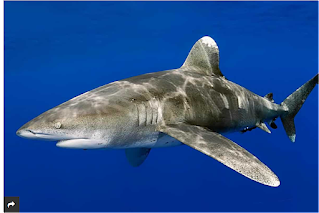Whitetip Shark: A Dangerous Species That Can Attack Man
The Whitetip Shark represents one of the five most dangerous species in the world, as it simply has no fear towards humans.
 |
| Whitetip Shark: A Dangerous Species That Can Attack Man |
Another feature that draws attention to this species would be the attack on humans by mistake.
In this way, continue reading and learn more information about Whitetip Shark, also including curiosities and distribution.
Classification:
- Scientific name – Carcharhinus longimanus;
- Family – Carcharhinidae
Whitetip Shark Characteristics
The Whitetip Shark also goes by the common name Oceanic Whitetip Shark, having a short, rounded snout.
The species has a dark gray coloration on the back, a tone that lightens when it is close to the flanks.
The belly would be yellowish and among the body characteristics that differentiate it, understand that the animal has hard rounded and long fins that have a light tone at the tips.
Another interesting point would be the teeth of the upper jaw, which have a triangular shape and a serrated edge.
In contrast, the teeth of the lower jaw would be pointed.
Individuals reach 2.5 m in total length and 70 kg in weight, in addition to the offspring being born with 65 cm.
Rare specimens are 4 m and weigh 168 kg.
Whitetip Shark Reproduction
The Whitetip Shark breeds in early summer when we are considering the Atlantic Ocean and the southwestern Indian Ocean.
But it is worth mentioning that some females captured in the Pacific were seen with embryos throughout the year, which suggests to researchers a longer breeding season in these regions.
So know that fish are viviparous and their young develop in the womb, in addition to being fed by a placental sac.
The gestation period would be 12 months and male individuals reach sexual maturity at 1.75 m, while females mature at 2 m.
Food
The Whitetip Shark is a slow animal, but it is active and excited when looking for food.
Even individuals can become aggressive.
Other characteristics that are related to food would be that the fish lives alone and swims in schools only when there is an abundance of food.
Thus, the white gall prefers to feed on oceanic fish, rays, crustaceans, seabirds, birds, gastropods, squid and turtles.
In addition, the species is opportunistic and can eat carrion, garbage or victims of sunken vessels when it is very hungry.
And as a strategy, the fish bite other fish and swim close to schools of tuna with their mouths open.
Another type of strategy would be to swim with the pilot whales.
Sharks have the habit of associating with whales because they are more capable when it comes to locating schools and animals such as squid.
Curiosities
The first curiosity about the Whitetip Shark would be its good performance in captivity.
Although not ideal for this type of breeding, the species offers more advantages than the mako shark or the blue shark.
According to some studies, it was possible to notice a development for more than a year in captivity.
Also, as a second curiosity, we should talk about attacks on human beings.
These attacks are considered rare, but an interesting point is that the shark has an indifferent behavior and no fear.
Thus, throughout history the species has always had the common name “man-eater” due to some attacks on the high seas.
And when accidents involving ships and aircraft occur, this would be the first species to be seen on site.
Where to find the Whitetip Shark
The White Gall Shark lives in tropical waters and warm regions, in addition to the open and deep oceans.
Therefore, it can be present all over the world, in places that have a temperature above 18 °C.
But, you need to know that the species prefers warmer waters like regions with temperature between 20 and 28 °C.
Individuals are also in cooler waters, with 15°C, but they always make migrations to warmer locations.
Therefore, understand that the fish stay at a depth of 150 m.
And we should also mention that the population of Whitetip Shark shows large drops.
This is because according to an analysis of logbook data from pelagic longliners, there has been a 70% decline.
The analysis was carried out in the Northwest and Midwest Atlantic between 1992 and 2000.
In the brackish waters of Gullmarsfjorden, Sweden, there was also a record of white gall with about 2 m in total length.
The animal’s appearance took place in September 2004, but the fish died shortly after being spotted.
Thus, this was the only record of the species’ presence in Northern Europe, which indicates that the distribution is becoming limited.
Finally, based on the evidence in the form of scars on the skin of a white gall filmed in Hawaii, we can conclude that this shark can dive deep enough to fight the giant squid.
Did you like the information? So leave your comment below, it’s important to us!

